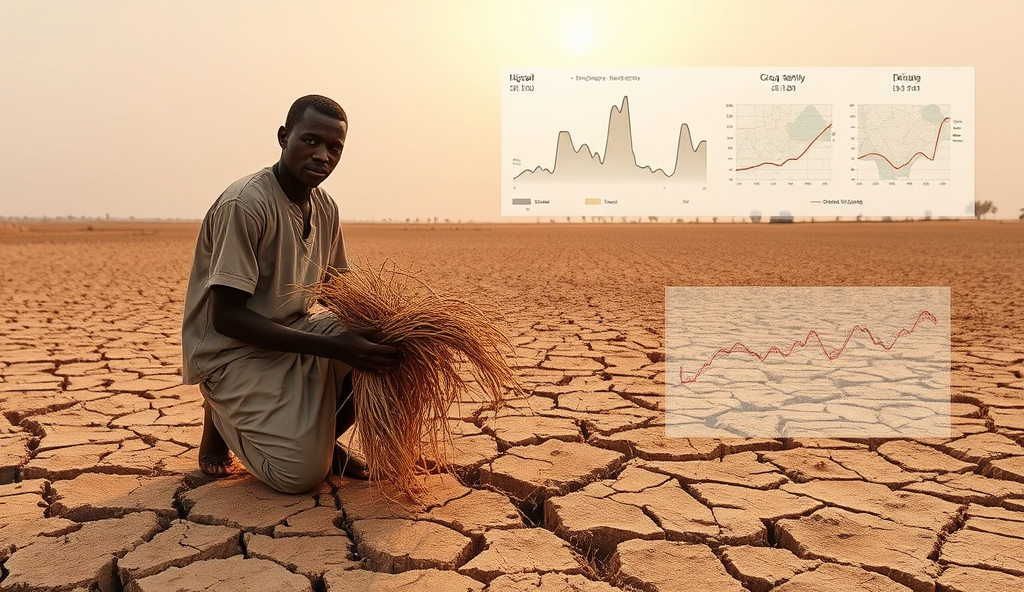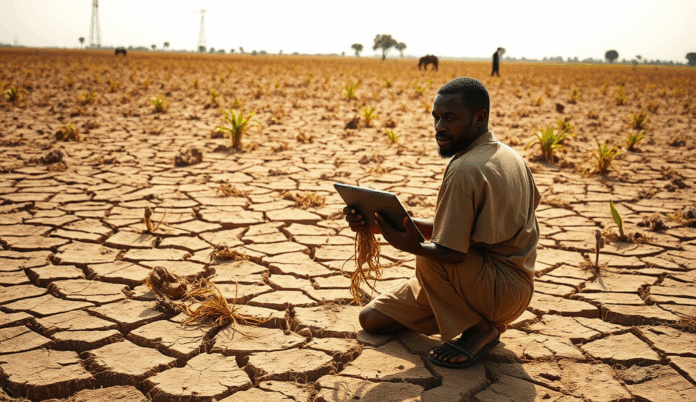Introduction to Crop Failure in Nigeria
Crop failure has become a growing concern for Nigerian farmers, with annual losses exceeding 40% for staple crops like maize and rice in some regions. This crisis stems from multiple interconnected factors, including erratic weather patterns and poor soil management practices that have intensified over the past decade.
Northern states like Sokoto and Kano face particularly severe challenges, where drought impact on Nigerian agriculture has reduced sorghum yields by up to 60% in bad years. Meanwhile, southern farmers grapple with opposite extremes as flooding leading to agricultural losses destroys entire cassava plantations during heavy rainy seasons.
These recurring failures create ripple effects, contributing to food insecurity due to poor harvests and economic losses from failed farming seasons across rural communities. As we’ll explore next, climate change effects on Nigerian crops represent one of the most pressing underlying causes of this complex challenge.
Key Statistics

Climate Change and Unpredictable Weather Patterns
Crop failure has become a growing concern for Nigerian farmers with annual losses exceeding 40% for staple crops like maize and rice in some regions.
Rising temperatures and shifting rainfall patterns have disrupted Nigeria’s traditional farming calendars, with the rainy season now starting 2-3 weeks later in northern states compared to a decade ago according to NIMET data. This delay forces farmers to either plant prematurely or miss optimal growing windows, directly contributing to low crop productivity in northern Nigeria.
Southern regions face different climate change effects on Nigerian crops, experiencing 35% more intense rainfall events that trigger flooding leading to agricultural losses, particularly in Delta and Rivers states. These extreme weather events destroy not just current harvests but also erode topsoil, creating compounding challenges that we’ll examine in the next section.
The drought impact on Nigerian agriculture has become particularly severe in the Sahel region, where 2022 yields dropped by 45% for millet and sorghum due to prolonged dry spells. Such climate-induced failures create food insecurity due to poor harvests while pushing smallholder farmers deeper into poverty cycles.
Poor Soil Quality and Degradation
Rising temperatures and shifting rainfall patterns have disrupted Nigeria's traditional farming calendars with the rainy season now starting 2-3 weeks later in northern states compared to a decade ago according to NIMET data.
The extreme weather patterns discussed earlier—flooding in the south and droughts in the north—have accelerated soil degradation, with 40% of Nigeria’s arable land now affected by nutrient depletion according to FAO reports. Heavy rains wash away fertile topsoil, while prolonged dry spells in the north reduce organic matter, creating a cycle of low crop productivity in northern Nigeria.
In states like Kano and Kaduna, over-farming without crop rotation has reduced soil fertility by 30% over two decades, forcing farmers to use more fertilizers at higher costs. This economic strain worsens food insecurity due to poor harvests, particularly for staple crops like maize and sorghum that rely on healthy soils.
As soils degrade further, they become more vulnerable to pest infestations, which we’ll explore next as another major contributor to crop failures. Without intervention, soil degradation will continue reducing farm output, compounding the challenges already posed by climate change effects on Nigerian crops.
Pest and Disease Infestations
The extreme weather patterns discussed earlier—flooding in the south and droughts in the north—have accelerated soil degradation with 40% of Nigeria's arable land now affected by nutrient depletion according to FAO reports.
Weakened soils from degradation, as discussed earlier, create ideal conditions for pests like fall armyworms, which destroyed over 50% of maize crops in northern Nigeria during the 2022 season. Climate change has expanded the range of invasive species, with locust swarms now threatening sorghum fields in states like Borno and Yobe.
Diseases like cassava mosaic virus reduce yields by 40-60% annually, costing Nigerian farmers over $1 billion in losses. Poor soil health exacerbates plant vulnerability, as nutrient-deficient crops lack natural resistance to infections.
These infestations force farmers into costly pesticide use, worsening the economic strain from soil degradation covered earlier. Next, we’ll examine how inadequate farming techniques further compound these challenges.
Inadequate Farming Practices and Techniques
Weakened soils from degradation as discussed earlier create ideal conditions for pests like fall armyworms which destroyed over 50% of maize crops in northern Nigeria during the 2022 season.
Compounding the challenges of soil degradation and pest infestations, many Nigerian farmers still rely on outdated techniques like continuous monocropping, which depletes soil nutrients and increases vulnerability to crop failure. A 2023 FAO report showed farms using traditional methods in Kano State yielded 30% less maize than those adopting modern practices.
Poor irrigation management during droughts and excessive tillage during floods worsen Nigeria’s climate-related crop losses, with 65% of smallholder farmers lacking access to proper water conservation training. These practices accelerate topsoil erosion, creating a vicious cycle with the soil health issues discussed earlier.
As we’ve seen, these technique gaps interact dangerously with other challenges, setting the stage for our next discussion on how limited access to quality seeds further constrains productivity.
Lack of Access to Quality Seeds and Inputs
Addressing crop failure in Nigeria requires a multi-pronged approach combining climate-smart practices like drought-resistant seeds with improved pest management as seen in successful maize farms in Kaduna.
The seed crisis compounds Nigeria’s existing farming challenges, with only 20% of smallholders accessing certified seeds according to the National Agricultural Seeds Council. Poor-quality seeds from informal markets often have low germination rates, worsening the yield gaps already caused by soil degradation and outdated techniques discussed earlier.
In northern states like Sokoto, farmers planting uncertified maize seeds report 40-50% lower yields compared to improved varieties, exacerbating food insecurity due to poor harvests. Limited access to fertilizers and pesticides further weakens crop resilience against climate change effects on Nigerian crops, creating a cycle of low productivity.
These input shortages directly impact farmers facing financial hardship from bad harvests, setting the stage for examining how water scarcity worsens these challenges.
Water Scarcity and Irrigation Challenges
Compounding the seed and input shortages, erratic rainfall patterns and prolonged droughts in northern Nigeria leave 60% of farmers relying solely on rain-fed agriculture, according to the Food and Agriculture Organization. States like Kano and Jigawa face up to 30% crop losses annually due to water scarcity, worsening food insecurity due to poor harvests in already vulnerable regions.
Despite Nigeria’s vast river systems, less than 1% of arable land utilizes irrigation, leaving farmers exposed to climate change effects on Nigerian crops. Smallholders often lack funds for drip irrigation or boreholes, forcing them to abandon fields during dry spells, further reducing productivity and deepening economic losses from failed farming seasons.
This water crisis intensifies soil degradation and pest infestations, creating a ripple effect that government policies and support systems must address to break the cycle of low yields. Without intervention, these challenges will continue to undermine food production, especially in arid regions where farming is already precarious.
Government Policies and Support Systems
To address the water scarcity and soil degradation highlighted earlier, Nigeria’s government has launched initiatives like the National Agricultural Growth Scheme (NAGS), offering subsidized irrigation equipment to smallholders in drought-prone regions. However, implementation gaps persist, with only 15% of targeted farmers in Kano accessing these resources due to bureaucratic delays and limited awareness.
Programs like the Anchor Borrowers’ Scheme provide low-interest loans for climate-resilient farming, yet repayment challenges and mismanagement have reduced their impact on crop productivity. States like Kebbi have seen success with localized interventions, such as community-led water harvesting projects, which could be scaled nationally to mitigate economic losses from failed farming seasons.
While policies exist, their effectiveness hinges on better coordination between federal and state agencies, as well as farmer education on sustainable practices. These systemic improvements are crucial before exploring how market access and pricing further influence agricultural outcomes.
Economic Factors and Market Access
Beyond production challenges, market inefficiencies exacerbate crop failure impacts, with post-harvest losses costing Nigerian farmers ₦3.5 trillion annually due to poor storage and transport networks. The Lagos-Kano railway project, if completed, could reduce spoilage by 40% for northern tomato farmers, demonstrating how infrastructure gaps directly affect economic losses from failed farming seasons.
Price volatility further strains smallholders, as seen in 2022 when maize prices dropped 30% post-harvest in Kaduna, forcing farmers to sell below production costs. While the Anchor Borrowers’ Scheme aimed to stabilize markets, its mismanagement has left many beneficiaries unable to repay loans after poor harvests, perpetuating cycles of debt.
Strengthening farmer cooperatives, like the Rice Farmers Association in Ebonyi, could improve collective bargaining against middlemen—a transitional step before discussing preventive measures for individual farms. These systemic market reforms must complement existing climate adaptation efforts to fully address crop productivity declines.
Preventive Measures for Farmers
To mitigate crop failure risks, Nigerian farmers should adopt climate-smart techniques like drought-resistant seed varieties, which increased sorghum yields by 25% in Kano during the 2021 dry season. Pairing these with precision irrigation, as demonstrated by Ogun State cassava growers, reduces water waste while maintaining soil moisture critical for root crops.
Post-harvest losses can be curbed through hermetic storage bags, proven to preserve 98% of stored grains for 12 months in Benue cooperatives, addressing the ₦3.5 trillion annual spoilage crisis mentioned earlier. Farmers should also leverage mobile apps like Farmcrowdy for real-time pest alerts, preventing infestations that destroyed 40% of northeast maize crops in 2020.
While systemic reforms progress, individual farms must implement crop rotation and organic composting to counter soil degradation—practices that raised yam productivity by 30% in Enugu pilot projects. These measures, combined with cooperative market strategies discussed earlier, create layered defenses against Nigeria’s multifaceted crop failure challenges.
Conclusion on Addressing Crop Failure in Nigeria
Addressing crop failure in Nigeria requires a multi-pronged approach, combining climate-smart practices like drought-resistant seeds with improved pest management, as seen in successful maize farms in Kaduna. Farmers must also leverage government initiatives like the Anchor Borrowers’ Program while adopting localized solutions such as crop rotation to combat soil degradation.
The economic losses from failed farming seasons, estimated at ₦3.5 trillion annually, highlight the urgency of adopting these measures. By integrating traditional knowledge with modern techniques, Nigerian farmers can mitigate risks from flooding and erratic rainfall patterns.
Moving forward, collaboration between researchers, policymakers, and farmers will be critical to scaling these solutions nationwide. The next steps involve strengthening early warning systems and expanding access to affordable irrigation technologies for smallholder farmers.
Frequently Asked Questions
What practical steps can I take to reduce crop failure risks from unpredictable rainfall?
Adopt drought-resistant seed varieties and use mobile apps like Farmcrowdy for weather alerts to time planting accurately.
How can I improve my soil quality without expensive fertilizers?
Practice crop rotation and organic composting which raised yam productivity by 30% in Enugu pilot projects.
Where can I access affordable irrigation solutions for my small farm?
Explore government programs like the National Agricultural Growth Scheme (NAGS) which offers subsidized irrigation equipment.
What storage methods can prevent post-harvest losses during market delays?
Use hermetic storage bags proven to preserve 98% of stored grains for 12 months as demonstrated in Benue cooperatives.
How can I protect my crops from pests without relying on costly pesticides?
Implement integrated pest management techniques and monitor fields regularly using free mobile apps for early detection.


